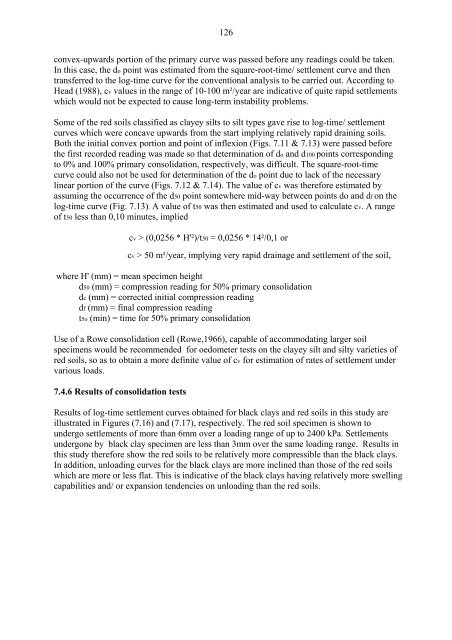an engineering geological characterisation of tropical clays - GBV
an engineering geological characterisation of tropical clays - GBV
an engineering geological characterisation of tropical clays - GBV
Create successful ePaper yourself
Turn your PDF publications into a flip-book with our unique Google optimized e-Paper software.
126<br />
convex-upwards portion <strong>of</strong> the primary curve was passed before <strong>an</strong>y readings could be taken.<br />
In this case, the do point was estimated from the square-root-time/ settlement curve <strong>an</strong>d then<br />
tr<strong>an</strong>sferred to the log-time curve for the conventional <strong>an</strong>alysis to be carried out. According to<br />
Head (1988), cv values in the r<strong>an</strong>ge <strong>of</strong> 10-100 m²/year are indicative <strong>of</strong> quite rapid settlements<br />
which would not be expected to cause long-term instability problems.<br />
Some <strong>of</strong> the red soils classified as clayey silts to silt types gave rise to log-time/ settlement<br />
curves which were concave upwards from the start implying relatively rapid draining soils.<br />
Both the initial convex portion <strong>an</strong>d point <strong>of</strong> inflexion (Figs. 7.11 & 7.13) were passed before<br />
the first recorded reading was made so that determination <strong>of</strong> do <strong>an</strong>d d100 points corresponding<br />
to 0% <strong>an</strong>d 100% primary consolidation, respectively, was difficult. The square-root-time<br />
curve could also not be used for determination <strong>of</strong> the do point due to lack <strong>of</strong> the necessary<br />
linear portion <strong>of</strong> the curve (Figs. 7.12 & 7.14). The value <strong>of</strong> cv was therefore estimated by<br />
assuming the occurrence <strong>of</strong> the d50 point somewhere mid-way between points do <strong>an</strong>d df on the<br />
log-time curve (Fig. 7.13). A value <strong>of</strong> t50 was then estimated <strong>an</strong>d used to calculate cv. A r<strong>an</strong>ge<br />
<strong>of</strong> t50 less th<strong>an</strong> 0,10 minutes, implied<br />
cv > (0,0256 * H'²)/t50 = 0,0256 * 14²/0,1 or<br />
cv > 50 m²/year, implying very rapid drainage <strong>an</strong>d settlement <strong>of</strong> the soil,<br />
where H' (mm) = me<strong>an</strong> specimen height<br />
d50 (mm) = compression reading for 50% primary consolidation<br />
dc (mm) = corrected initial compression reading<br />
df (mm) = final compression reading<br />
t5o (min) = time for 50% primary consolidation<br />
Use <strong>of</strong> a Rowe consolidation cell (Rowe,1966), capable <strong>of</strong> accommodating larger soil<br />
specimens would be recommended for oedometer tests on the clayey silt <strong>an</strong>d silty varieties <strong>of</strong><br />
red soils, so as to obtain a more definite value <strong>of</strong> cv for estimation <strong>of</strong> rates <strong>of</strong> settlement under<br />
various loads.<br />
7.4.6 Results <strong>of</strong> consolidation tests<br />
Results <strong>of</strong> log-time settlement curves obtained for black <strong>clays</strong> <strong>an</strong>d red soils in this study are<br />
illustrated in Figures (7.16) <strong>an</strong>d (7.17), respectively. The red soil specimen is shown to<br />
undergo settlements <strong>of</strong> more th<strong>an</strong> 6mm over a loading r<strong>an</strong>ge <strong>of</strong> up to 2400 kPa. Settlements<br />
undergone by black clay specimen are less th<strong>an</strong> 3mm over the same loading r<strong>an</strong>ge. Results in<br />
this study therefore show the red soils to be relatively more compressible th<strong>an</strong> the black <strong>clays</strong>.<br />
In addition, unloading curves for the black <strong>clays</strong> are more inclined th<strong>an</strong> those <strong>of</strong> the red soils<br />
which are more or less flat. This is indicative <strong>of</strong> the black <strong>clays</strong> having relatively more swelling<br />
capabilities <strong>an</strong>d/ or exp<strong>an</strong>sion tendencies on unloading th<strong>an</strong> the red soils.
















